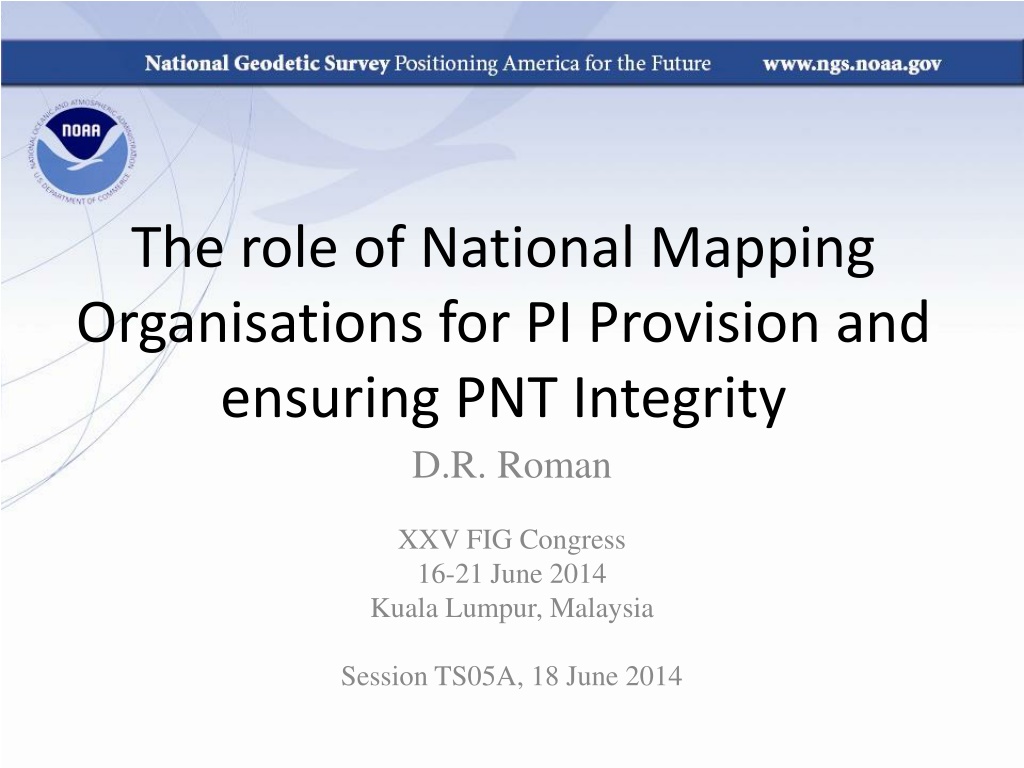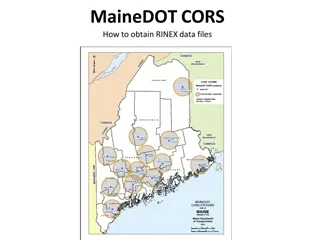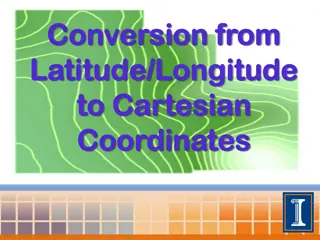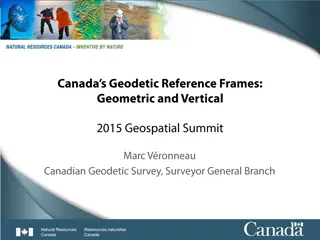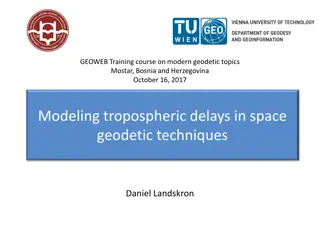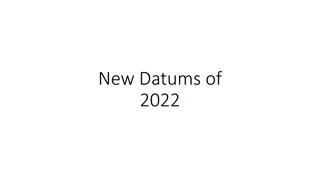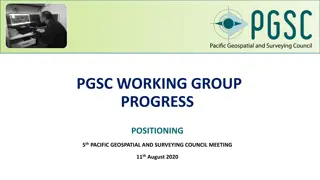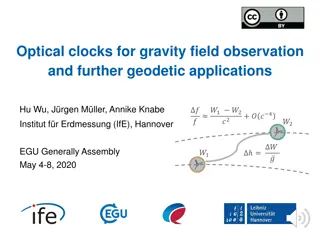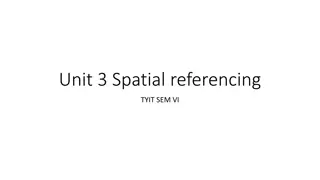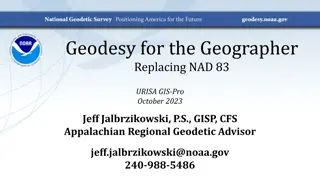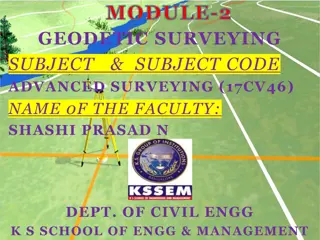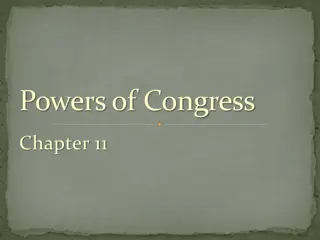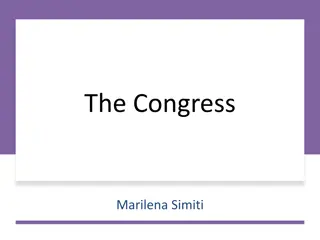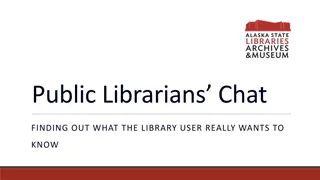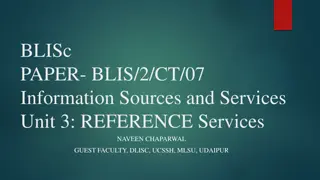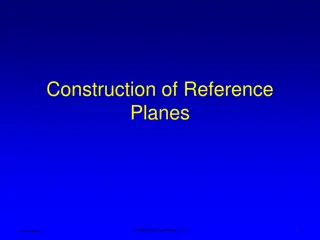Advancements in Geodetic Reference Systems and CORS Networks at XXV FIG Congress
Explore the latest updates from the XXV FIG Congress regarding the role of National Mapping Organisations in providing Positioning Infrastructure and ensuring Precision Navigation and Timing Integrity. Key highlights include NAD 83 replacement, CORS enhancements, alignment strategies, transformation parameters, plate rotation models, and advancements in CORS networks. Discover the significant developments shaping the geodetic reference frame landscape.
- Geodetic Reference Systems
- National Mapping Organisations
- XXV FIG Congress
- CORS Networks
- Positioning Infrastructure
Download Presentation

Please find below an Image/Link to download the presentation.
The content on the website is provided AS IS for your information and personal use only. It may not be sold, licensed, or shared on other websites without obtaining consent from the author. Download presentation by click this link. If you encounter any issues during the download, it is possible that the publisher has removed the file from their server.
E N D
Presentation Transcript
The role of National Mapping Organisations for PI Provision and ensuring PNT Integrity D.R. Roman XXV FIG Congress 16-21 June 2014 Kuala Lumpur, Malaysia Session TS05A, 18 June 2014
OUTLINE NAD 83 Replacement CORS Enhancements OPUS-Projects RTN Support Outlook 18 June 2014, Session TS05A XXV FIG Congress, Kulala Lumpur, Malaysia 16-21 June 2014 5
NAD 83 Replacement Continental plate-fixed geodetic datum to be adopted in the United States More geocentric than the current NAD 83 reference frame Must coordinate with Mexico and Canada By 2022, reduce all definitional and access related errors in the geometric reference frame to 1 centimeter when using 15 minutes of GNSS data 18 June 2014, Session TS05A 16-21 June 2014 XXV FIG Congress, Kulala Lumpur, Malaysia 6
Two possible ways to align Using a newly defined NGS network such as the projected foundation CORS. Must build a sufficient number prior to 2022 to establish a viable, independent national network Rely on stations currently in the IERS network located in the North American continent. Presumes continued NGS participation in IERS (AC) 18 June 2014, Session TS05A XXV FIG Congress, Kulala Lumpur, Malaysia 16-21 June 2014 7
Two Important Questions What will be the 14-parameter transformation between the redefined geodetic reference datum frame and the standard geocentrically assumed ITRFxxxx frame? What will be the adopted plate rotation models introduced to correct for the North America, Pacific, Mariana and Caribbean plate rotations? HTDP will be relied upon to propagate these transformations in a consistent manner 18 June 2014, Session TS05A XXV FIG Congress, Kulala Lumpur, Malaysia 16-21 June 2014 8
CORS Networks Stations As of February 2014, all CORS stations provide extra signals beyond current GPS L1 and L2: GPS's L2C and L5 Russia's GLONASS satellites L1 and L2 Over 40% of CORS sites will distribute these extra signals These additional signals also enhance system robustness and better ensure PNT 18 June 2014, Session TS05A XXV FIG Congress, Kulala Lumpur, Malaysia 16-21 June 2014 9
Satellite Orbital Processing NGS continues to serve as an Analysis Center (AC) for the IERS GPS satellite orbital processing is key to overall accuracy and contribution to future ITRF models NGS must expand to perform additional orbital analysis for other GNSS (e.g., GLONASS) Accuracy of orbits and data archived from the CORS Network stations are critical to success 18 June 2014, Session TS05A XXV FIG Congress, Kulala Lumpur, Malaysia 16-21 June 2014 10
OPUS-Projects Utilizing the GNSS data from CORS and rovers Data are loaded through OPUS(-Static) Project name is tagged A series of adjustments are performed: OPUS-S: for each observation set at a station Session: for all points observed at the same time Network: least squares combination of sessions Performs a network adjustment at the local level 18 June 2014, Session TS05A XXV FIG Congress, Kulala Lumpur, Malaysia 16-21 June 2014 11
Network Components Think of project as having 2 components: Local network Think precision - get best relative positions. Reference network Think accuracy - multiple CORS tie the local network into NSRS. 2014-05-29 Suggested Processing Guidance 12
Local Network Think precision - get best relative positions: Use common-mode errors to your advantage. Use identical antennas when possible. Keep baselines short maximizing simultaneous observations. Use a single Hub per session. Use the same Hub for all sessions when possible. Include at least one distant CORS to stabilize tropo corrections. Normal constraints. 2014-05-29 Suggested Processing Guidance 13
Reference Network Think accuracy - multiple CORS tie the local network into NSRS: Include the Hub(s) and distant CORS in all sessions. Multiple CORS remove single reference mark bias. Normal constraint weights allow for small variations in positions typical of CORS or any mark. 2014-05-29 Suggested Processing Guidance 14
Example 6: Single project Hub Not too bad but much better 2014-05-29 Suggested Processing Guidance 15
RTN Validation NGS does nothave regulatory authority over RTN s Provide, by 2015, a process for RTN operators to validate that their RTNs are aligned to the NSRS using NGS-acceptable standards. Make the tool available to RTN customers, too Use OPUS-Projects for State-wide systems Enhances robustness of solutions by providing alternative means for passing correction information to rover receivers (RTN/RTK) 18 June 2014, Session TS05A XXV FIG Congress, Kulala Lumpur, Malaysia 16-21 June 2014 16
RTN Basics City limits City limits 100 100 Ref. Ref. Northing (km) Ref. Northing (km) * * Ref. Ref. 0 0 0 Easting (km) 100 0 Easting (km) 100 Single baseline approach Network approach
RTN Basics Reference frame adopt latest realization of NAD 83 (NAD 83 2011 epoch 2010.00) CORS + RTN include a few CORS in the RTN Adjustments Constrain CORS that are included Base station monitoring Process data periodically Monitor coordinates over time Base station information Coordinates, velocities, epoch
SUMMARY NAD 83 replacement will be more geocentric Tied through 14-parameter transformation to ITRF Goal by 2022: 15 minutes of GNSS for 1 cm accuracy CORS data already storing GLONASS+GPS More to follow Need orbits for all GNSS Access to the future NSRS will be by: OPUS-Projects for geodetic control data RTN s for real-time applications 18 June 2014, Session TS05A XXV FIG Congress, Kulala Lumpur, Malaysia 16-21 June 2014 20
Contact Information Daniel R. Roman, National Geodetic Survey Chief (acting) SRSD/GRAV-D P.I./Geoid Team Lead dan.roman@noaa.gov 301-713-3200 x103 Relevant NGS webpages: CORS: http://www.ngs.noaa.gov/CORS/ OPUS Page: http://www.ngs.noaa.gov/OPUS/ OPUS-Projects: http://www.ngs.noaa.gov/OPUS- Projects/OpusProjects.shtml 17 June 2014, Session TS01A, Paper 7303 XXV FIG Congress, Kulala Lumpur, Malaysia 16-21 June 2014 21
